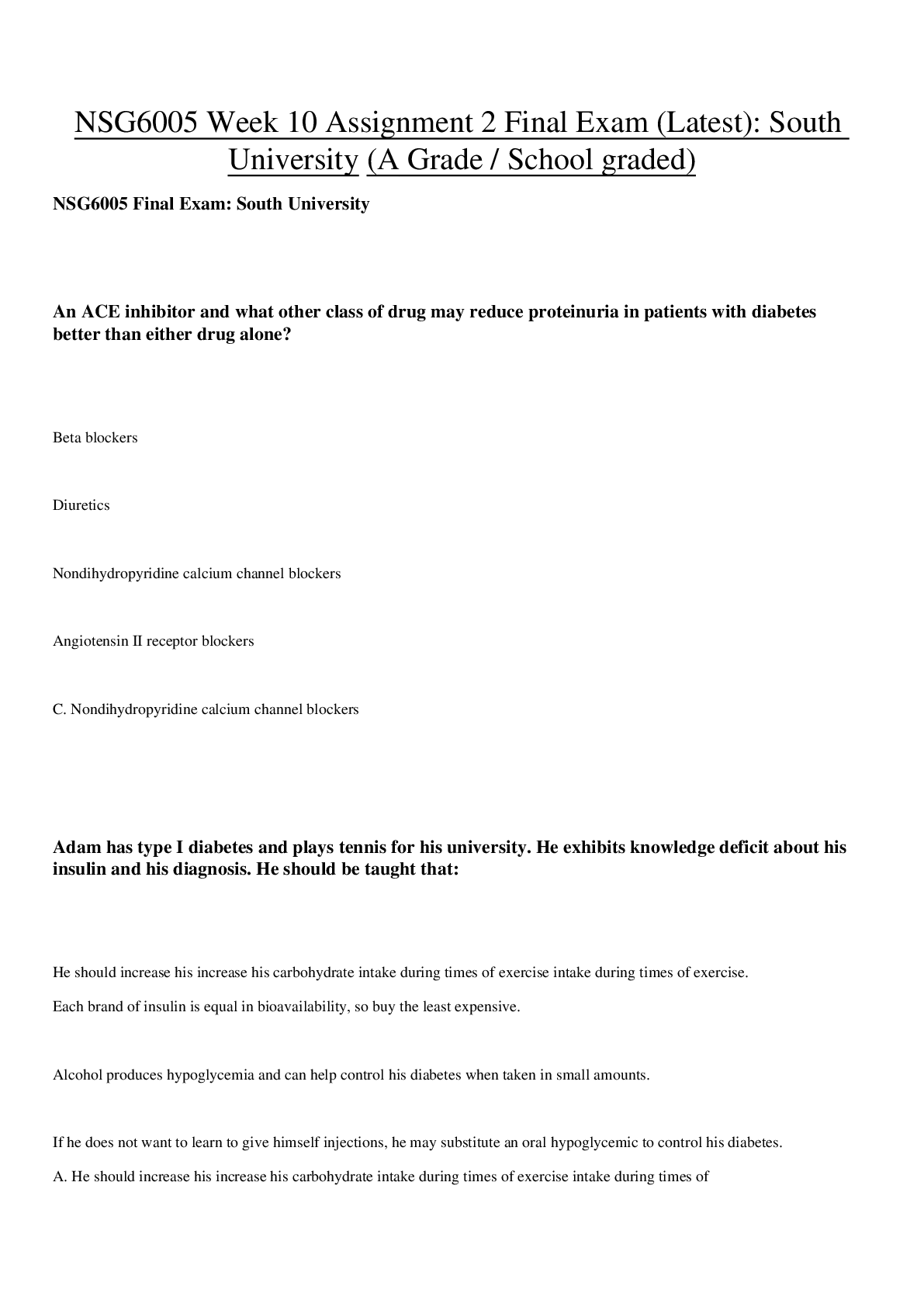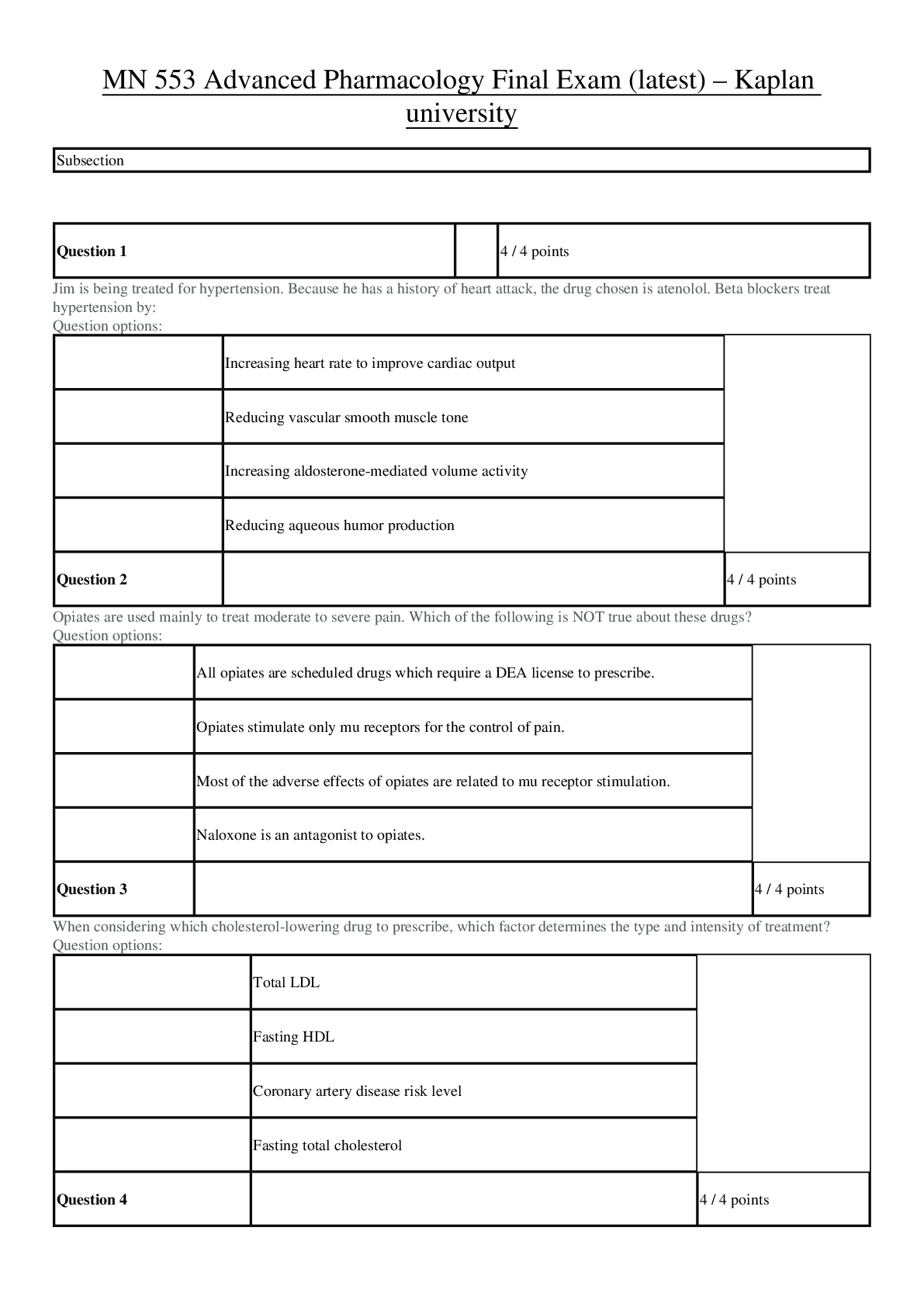*NURSING > EXAM > NUR211 Final Exam (100 Q/A) / NUR 211 Final Exam (Latest UPDATE): Fundamentals of Professional Nursi (All)
NUR211 Final Exam (100 Q/A) / NUR 211 Final Exam (Latest UPDATE): Fundamentals of Professional Nursing: Rasmussen College.
Document Content and Description Below
NU211 Fundamentals of Professional Nursing Final Exam NU 211 Final Exam / NU211 Final Exam (Latest): Fundamentals of Professional Nursing: Rasmussen College Question 1 1.5 out of 1.5 points When asses... sing a 2-3 year old child, what is important to consider? Answers: Assess least invasive to most invasive. Start with examining the ears and mouth. Make sure to examine the child lying on the exam table. It’s easier to examine the child if the parent is not in the room. Question 2 1.5 out of 1.5 points The nurse notes an audible, crunching/grating sound on the client’s knee while climbing the stairs. Choose the best term. Answers: Crepitus Bulge sign Ballottement Inversion Question 3 1.5 out of 1.5 points The nurse palpates the left upper quadrant of abdomen with the knowledge that which organs are located in that area? Answers: Liver and gallbladder. Pancreas and spleen Large intestine and liver Left ureter and gallbladder Question 4 1.5 out of 1.5 points Identify which reflex is being tested in this picture. Answers: Plantar Patellar Triceps Achille’s Question 5 1.5 out of 1.5 points The clinic nurse assesses the skin of a white client with a diagnosis of psoriasis. The nurse understands that which characteristic is associated with this skin disorder? Answers: Clear, thin nail beds Red-purple raised areas Oily skin and no episodes of pruritus Silvery-white scaly patches on the scalp, elbows, knees, and sacral regions Question 6 1.5 out of 1.5 points "When testing stool for occult blood, the nurse is aware that a false-positive result may occur with:" Answers: a large amount of red meat within the last 3 days. absent bile increased fat content increased ingestion of fruit Question 7 1.5 out of 1.5 points The nurse is preparing to complete a musculoskeletal examination on a client. Which two assessment techniques would the nurse plan to use during this exam? Answers: Inspection and percussion Percussion and palpation Auscultation and percussion Inspection and palpation Question 8 1.5 out of 1.5 points While assessing edema on a client’s lower leg, the nurse notices a deep imprint of his fingers where the leg was palpated which takes several minutes to resolve. How would the nurse document this finding? Answers: No edema 1 edema 3 edema 4 edema Question 9 1.5 out of 1.5 points The nurse is performing an assessment on an older client having difficulty sleeping at night. Which statement indicates that teaching about improving sleep is necessary? Answers: "I drink hot chocolate before bed" "I swim three times a week" "I have stopped smoking cigars" "I read for 40 minutes before bed" Question 10 1.5 out of 1.5 points "After completing a comprehensive health assessment of a client, which of the following statement is subjective data?" Answers: The client complains of itching The client s skin feels warm to the touch The client is scratching his arm The client s temperature is 100°F Question 11 1.5 out of 1.5 points Which of the following statements is most appropriate when the nurse is obtaining a genitourinary history from an elderly man? Answers: Do you need to get up at night to urinate? " Do you experience nocturnal emissions, or wet dreams? " Do you know how to perform urinary self-examination? Has anyone ever touched your genitals and you did not want them to? Question 12 1.5 out of 1.5 points "During a breast health interview, a client states that she has noticed pain in her left breast. The nurse s most appropriate response to this would be:" Answers: I would like some more information about the pain in your left breast. Don t worry about the pain; breast cancer is not painful. I would like some more information about the pain in your right breast. Breast pain is almost always the result of benign breast disease and so let s just ignore it. Question 13 1.5 out of 1.5 points The Glasgow Coma Scale is used to grade neurological responses to which three parameters? Answers: Eye opening, verbal response, motor response Verbal response, pain response, reflexes Pupil response, motor response, reflexes Motor movement and strength, reflexes, pupillary size and reaction Question 14 1.5 out of 1.5 points If a nurse uses their hand to press down into the abdomen to assess for tenderness, the nurse is performing which technique? Answers: Palpation Inspection Auscultation Percussion Question 15 0 out of 1.5 points "While obtaining a history of a 3-month old infant from the mother, the nurse asks about the baby s ability to suck and grasp the mother s finger. What is the nurse assessing?" Answers: Reflexes Intelligence Cranial atrophy Thalmus function Question 16 1.5 out of 1.5 points An 85-year-old patient comments during his annual physical that he seems to be getting shorter as he ages. The nurse should explain that decreased height occurs with aging because: Answers: of the shortening of the vertebral column. long bones tend to shorten with age. there is a significant loss of subcutaneous fat. there is a thickening of the intervertebral discs. Question 17 1.5 out of 1.5 points A client asks, “Why is touching my toes necessary? This is a sports physical examination not an exercise class.” How would the nurse reply? Answers: “This is the best way to check for symmetry of your arms.” “I am looking at the stretch of your ham strings.” “This allows me to see how straight your spinal column is.” “It is considered abnormal if you can’t touch your toes from this position.” Question 18 1.5 out of 1.5 points Medication administration or procedural errors can be prevented by completing which task? Answers: Ensuring the room is temperature controlled Closing the door and curtain Washing your hands Asking the client to give their name and date of birth Question 19 1.5 out of 1.5 points The nurse is assessing an older adult’s functional ability. What is the definition of functional ability? Answers: The measure of the expected changes of aging that one is experiencing The individual’s motivation to live independently The level of cognition present in an older person One’s ability to perform activities necessary to live in modern society Question 20 0 out of 1.5 points A client s respirations are 44. These respirations are considered to be which of the following? Answers: Tachypneic Apneic Eupneic Bradypneic Question 21 1.5 out of 1.5 points The client complains of ringing, crackling or buzzing in the ear. Choose the best term. Answers: Tinnitus Tympanic Otitis media Pinna Question 22 1.5 out of 1.5 points Which data do nurses document under the category of Family Health History? Answers: Present illness Allergies to medications Maternal Diseases Name and date of birth Question 23 1.5 out of 1.5 points The client has stiffness and fixation of a joint. Choose the correct term for this. Answers: Contracture Ankylosis Dislocation Subluxation Question 24 1.5 out of 1.5 points The most important technique when progressing from one auscultatory site on the thorax to another is: Answers: side-to-side comparison. top-to-bottom comparison. posterior-to-anterior comparison. interspace-by-interspace comparison. Question 25 1.5 out of 1.5 points The nurse notes fanning of the toes when the sole of the foot of an adult client is stimulated during assessment of the plantar reflex. How would the nurse chart this correctly? Answers: Babinski response Brudzinski sign Nuchal rigidity Hyperreflexia Question 26 1.5 out of 1.5 points The nurse should use which location for eliciting a deep tendon reflex? Answers: Achilles Femoral Scapula Abdomen Question 27 1.5 out of 1.5 points What would the nurse ask in order to gain insight into a disabled client’s functional ability? Answers: “When did the disability first begin?” “How has your disability affected your daily life?” “Why did you come to the clinic today?” “How do you feel about your disability?” Question 28 1.5 out of 1.5 points What is an example of objective data? Answers: A client receiving chemotherapy complains of nausea. A client states that they are feeling very anxious about their tests A client with an inner ear infection complains of dizziness The skin of a client who has liver failure has a yellowish tint. Question 29 1.5 out of 1.5 points The nurse is assessing the motor function of an unconscious client. The nurse would plan to use which of the following to test the clients peripheral response to pain? Answers: Nail bed pressure Sternal rub Pressure on the orbital rim Squeezing of the sternocleidomastoid muscle Question 30 1.5 out of 1.5 points "When assessing a client s lungs, the nurse recalls that the left lung:" Answers: consists of two lobes is divided by the horizontal fissure. consists primarily of an upper lobe on the posterior chest. is shorter than the right lung because of the underlying stomach. Question 31 1.5 out of 1.5 points A client has hypoactive bowel sounds. The nurse knows that a potential cause of hypoactive bowel sounds is: Answers: peritonitis. diarrhea. laxative use. gastroenteritis. Question 32 1.5 out of 1.5 points What activity would the nurse perform first when assessing a client’s urinary elimination status? Answers: Obtain a nursing history Interpret results of diagnostic tests Perform a physical examination Goal setting with the client. Question 33 1.5 out of 1.5 points An 85-year-old man has been hospitalized after a fall at home, and his 86-year-old wife is his primary caregiver. The nurse should assess for signs of caregiver burnout. What is a sign of this burnout? Answers: Anxiety or depression Weight gain Hypertension Respiratory status Question 34 1.5 out of 1.5 points When assessing the range of motion of the client’s knee, the nurse expects the client to be able to perform which movement? Answers: Flexion and extension Circumduction and external rotation Adduction and rotation Flexion and supination Question 35 1.5 out of 1.5 points What is the correct term for when the client’s muscle is relaxed and the nurse moves a body part? Answers: Active ROM (range of motion) Myalgia Passive ROM (range of motion) Atrophy Question 36 1.5 out of 1.5 points The nurse is comparing the right and left legs of a client and notices that they are asymmetric in size. What additional data might the nurse collect at this time? Answers: Passively move each leg through range of motion and compare findings Observe the client’s gait and legs as they walk across the room Measure the circumference of each leg and compare the findings Palpating the joints and muscles of each leg and compare the findings Question 37 1.5 out of 1.5 points The sac that surrounds and protects the heart is called the: Answers: Pericardium Myocardium Endocardium Pleural space Question 38 1.5 out of 1.5 points What does thoracic expansion assess? Answers: Vibrations Voice sounds Breath sounds Chest movement Question 39 1.5 out of 1.5 points The nurse asks the client to puff out their cheeks and lift their eyebrows. Which cranial nerve is the nurse assessing? Answers: Optic nerve, cranial nerve II Facial nerve, cranial nerve VII Trigeminalnerve, cranial nerve V Abducens nerve, cranial nerve VI Question 40 1.5 out of 1.5 points What is the meaning of the term PERRLA? Answers: Pupils equal, round, reaction to light and accommodation Pupils equate to roundness and reactiveness always. Pupils equally react with roundness and light accommodation Pupils equal and reactive to light assessment Question 41 1.5 out of 1.5 points The nurse is explaining to a client that there are shock absorbers in his back to cushion the spine and to help it move. The nurse is referring to his: Answers: Intervertebral discs Costal Facets Nucleus Pulposus Vertebral foramen Question 42 1.5 out of 1.5 points The nurse auscultates a blowing, swooshing sound of an area of abnormal blood flow. Choose the best term. Answers: Dysphagia Macro cephalic Kinesthesia Bruit Question 43 1.5 out of 1.5 points The nurse has determined that the client’s bowel sounds are normal. What sounds did the nurse hear? Answers: Loud, high pitched, rushing, and tinkling sounds Like two pieces of leather being rubbed together Rare bubbly or blowing sound High pitched, irregular gurgling sounds Question 44 1.5 out of 1.5 points A client is seen in the clinic for a routine blood pressure assessment and states they have been experiencing the normal pain associated with aging. Which statement by the nurse is most therapeutic? Answers: “You must have osteoarthritis.” “Do you take medications for the discomforts you are experiencing?” “Normal aging can be quite painful.” “Tell me more about your pain and discomfort.” Question 45 1.5 out of 1.5 points A patient is having difficulty in swallowing medications and food. The nurse would document that this patient has: Answers: aphasia dysplasia dysphagia myophagia Question 46 1.5 out of 1.5 points A 4-year-old client is brought to the emergency department a parent. The parent states that the child points to their stomach and says “It hurts so bad”. Which pain assessment tool would be the best choice when assessing this child’s pain? Answers: Descriptor scale Numeric rating scale Brief pain inventory Faces pain scale Question 47 1.5 out of 1.5 points "The nurse notes that a client has had a black, tarry stool and recalls that a possible cause would be:" Answers: gastrointestinal bleeding gallbladder disease overuse of laxatives localized bleeding around the anus Question 48 1.5 out of 1.5 points Which of the following statements is true regarding the internal structures of the breast? Answers: "The breast is composed of fibrous, glandular, and adipose tissue." "The breast is mainly muscle, with very little fibrous tissue." "The breast is composed mostly of milk ducts, known as lactiferous ducts." The breast is composed of only glandular tissue. Question 49 1.5 out of 1.5 points Which term is used to denote the movement of a limb towards the body? Answers: Adduction Abduction Annulus Anthropometrics Question 50 1.5 out of 1.5 points The part of the cardiac cycle in which the ventricles are relaxed and filling with blood is called which of the following? Answers: Diastole Systole Hypotension Symptom Question 51 1.5 out of 1.5 points A 46-year-old man requires assessment of his sigmoid colon. Which of the following is most appropriate for this examination? Answers: Colonoscopy Proctoscope Ultrasound A rectal exam with an examining finger Question 52 1.5 out of 1.5 points "During a health history of a patient who complains of chronic constipation, she asks the nurse about high-fiber foods. The nurse relates that an example of a high-fiber food would be:" Answers: broccoli hamburger french fries white dinner roles Question 53 1.5 out of 1.5 points Which pulse site is typically used to obtain a pulse rate from a client? Answers: Radial Temporal Posterior tibial Femoral Question 54 1.5 out of 1.5 points Chose the best term for the sound will the nurse will hear at the left midclavicular, fifth intercostal space? Answers: Thrill Heave Apical Pulse Murmur Question 55 1.5 out of 1.5 points Which is an example of objective data a nurse would collect during a physical examination? Answers: The client s radial and pedal pulses The client s stated concern about lack of money for prescriptions The client s complaints of tingling sensations in the feet The client s mother s statements that the client has been very nervous lately Question 56 1.5 out of 1.5 points The client has continuous tonic spasm of a muscle. Choose the correct term Answers: Tetany Tremor Atrophy Myalgia Question 57 1.5 out of 1.5 points The client complains of a sense that the room is spinning around. Choose the best term. Answers: Disequilibrium Vertigo Presyncope Fixation Question 58 1.5 out of 1.5 points In which situation should the nurse screen for intimate partner violence (IPV)? Answers: When IPV is suspected When a woman has an unexplained injury As a routine part of each health care encounter When a history of abuse in the family is known Question 59 1.5 out of 1.5 points What would the nurse expect to note when assessing a lesion diagnosed as malignant melanoma? Answers: An asymmetric black lesion A small papule with a dry, rough scale A firm nodular lesion topped with crust. A pearly papule with a central crater and a waxy border. Question 60 1.5 out of 1.5 points The nurse knows that the incidence of osteoporosis is greatest in which group? Answers: White women Black Men Black Women American Indian men Question 61 1.5 out of 1.5 points What is a term for a nutritional abnormality represented by recurrent binge and purge eating cycle? Answers: Bulimia Anorexia Binge eating Nervosa eating Question 62 1.5 out of 1.5 points A patient states, “Whenever I open my mouth real wide, I feel this popping sensation in front of my ears.” How would the nurse further examine this complaint? Answers: Place the stethoscope over the temporomandibular joint, and listen for bruits. Place the hands over the client’s ears, and ask the client to open their mouth “really wide. ” Place one hand on the client’s forehead and the other on their jaw, and ask the client to try to open their mouth. Place a finger over each of the client’s temporomandibular joints, and ask the client to open and close their mouth. Question 63 1.5 out of 1.5 points A client has a normal pupillary light reflex. The nurse recognizes that this indicates that: Answers: constriction of both pupils occurs in response to bright light the eyes converge to focus on the light light is reflected at the same spot in both eyes they focuses the image in the center of the pupil. Question 64 0 out of 1.5 points Which assessments would be appropriate for evaluating cerebellar function? (Select all that apply) Answers: Heel to shin test Finger to nose test Rapid alternating fingers Weber test Stereognosis Question 65 1.5 out of 1.5 points A patient has been diagnosed with venous stasis. Which of the following would the nurse most likely observe? Answers: A brownish discoloration to the skin of the lower leg A unilateral cool foot "Thin, shiny, atrophic skin" Pallor of the toes and cyanosis of the nailbeds Question 66 1,5 out of 1.5 points "When the nurse asks a 68-year-old client to stand with feet together and arms at his side with his eyes closed, he starts to sway and moves his feet further apart. The nurse would document this finding as a:" Answers: Positive Romberg's sign Lack of time and space. Pataxia Negative Homan's sign Question 67 1.5 out of 1.5 points A client tells the nurse, “I have to sleep propped up with 3 pillows so I can breathe at night.” How would the nurse document this? Answers: Orthopnea. Acute Emphysema. Paroxysmal Nocturnal Dyspnea. Acute Shortness of Breath Episode. Question 68 1.5 out of 1.5 points "During an annual physical exam, a 43-year-old client states that she doesn t perform monthly breast self-examinations. She tells the nurse that she believes that mammograms do a much better job than I ever could to find a lump. The nurse should explain to her that:" Answers: mammography may not detect all palpable lumps. breast self-examination is unnecessary until the age of 50 years. "she is correct, mammography is a good replacement for breast self-examination." she doesn t need to perform breast self-examination as long as a physician checks her breasts yearly. Question 69 1.5 out of 1.5 points The nurse is performing an assessment on a preschool aged client. Which method will aid in the ability to gather needed data? Answers: Allow the child to touch or try equipment before the exam Explain all the abnormalities you might find Ask the mother to leave the room Tell the child they must cooperate Question 70 1.5 out of 1.5 points On auscultating lung sounds in the adult client, the nurse documents which finding as normal? Answers: Bronchial sounds heard over the trachea and larynx Bronchovesicular sounds heard over the majority of the lung fields posteriorly Vesicular sounds near the sternal border bilaterally Tracheal sounds over the periphery of the lung fields Question 71 1.5 out of 1.5 points A nurse is inspecting the ear canal of an adult client. Which is the best method to move the pinna in order to straighten the ear canal to better visualize the area? Answers: There is no need to move the pinna Gently pull the pinna up and back Gently pull the pinna down and back Pull the pinna horizontal to the side of the head Question 72 1.5 out of 1.5 points What area would the nurse listen to if wishing to listen to the tricuspid valve area? Answers: Area 1 Area 2 Area 3 Area 4 Area 5 Question 73 1.5 out of 1.5 points The nurse noted a protrusion of the sternum and adjacent costal cartilage. Choose the correct term. Answers: Pectus carinatum Barrel Chest Pectus excavatum Kyphosis Question 74 1.5 out of 1.5 points A client’s respirations are 8. How could these respirations be documented? Answers: Apneic Eupneic Tachypneic Bradypneic Question 75 1.5 out of 1.5 points The nurses assesses the posterior tibial pulse by lightly palpating in which location? Answers: Behind the knee in the popliteal fossa The inner aspect of the ankle below and slightly behind the medial malleolus Over the dorsum of the foot between the extensor tendon of the 1st and 2nd toe The outer aspect of the ankle below and slightly behind the lateral malleolus Question 76 1.5 out of 1.5 points What risk factors for osteoporosis? Answers: Smoking Steroid use Heavy bone structure Being Caucasian Male gender Question 77 1.5 out of 1.5 points The nurse is assessing an adult who has a pulse rate of 180 beats/minute. Which condition would the nurse document? Answers: Tachycardia Pulse amplitude Bradycardia Arrythmia Question 78 1.5 out of 1.5 points A woman who is 8 months pregnant comments that she has noticed a change in posture and is having lower back pain. The nurse tells her that during pregnancy women have a posture shift to compensate for the enlarging fetus. This shift in posture is known as: Answers: Lordosis Scoliosis Ankylosis Kyphosis Question 79 1.5 out of 1.5 points The nurse is aware that a change that may occur in the gastrointestinal system of an aging adult is: Answers: decreased gastric acid secretion increased salivation megacolon increased esophageal emptying Question 80 1.5 out of 1.5 points What is the purpose of the side to side pattern used during respiratory assessment? Answers: Prevent fatiguing the client Tightly organize the assessment Allow comparison of like areas of the lungs Conserve time Question 81 1.5 out of 1.5 points "A nurse notes that a client has ascites, which indicates that which of the following is present?" Answers: Fluid Feces Flatus Fibroid tumors Question 82 1.5 out of 1.5 points What should the nurse do when there is difficulty eliciting a patellar reflex? Answers: Strike the knee harder Have the client use the reflex hammer on themselves Have the client lock their fingers together and try to pull them apart Keep trying to use the hammer in slightly different areas of the knee Question 83 1.5 out of 1.5 points The nurse documents that a client’s accommodation is normal when which situation occurs? Answers: The client has peripheral vision of 90 degrees The client’s eyes move up and down, side to side, and obliquely The right pupil constricts when a light is shown in the left eye The client’s pupils constrict when looking at a close object Question 84 1.5 out of 1.5 points "In assessing a patient s major risk factors for heart disease, which would the nurse want to include when taking a history?" Answers: "Smoking, hypertension, obesity, diabetes, high cholesterol" "Work history, hypertension, stress, age" "Personality type, high cholesterol, diabetes, intense exercise" "Sugar consumption, anorexia, diabetes, stress, high cholesterol" Question 85 1.5 out of 1.5 points The nurse is performing an abdominal assessment and inspects the skin on the abdomen. The nurse performs which assessment technique next? Answers: Palpates the abdomen for size Palpates the liver at the right rib margin Listens to bowel sounds in all four quadrants Percusses the right lower abdominal quadrant Question 86 1.5 out of 1.5 points A 30-year-old woman tells the nurse that she has been very unsteady and has had difficulty in maintaining her balance. Which area of the brain would the nurse be concerned about with these findings? Answers: Cerebellum Thalamus Brainstem Extrapyramidal tract Question 87 1.5 out of 1.5 points What is the part of the cardiac cycle in which the ventricles are contracting and pushing blood out of the chambers? Answers: Systole Diastole Hypotension Symptom Question 88 1.5 out of 1.5 points During an interview, the client answers questions quietly and appears sad. While answering questions about her marriage, she begins to cry. Which is the nurse’s appropriate response? Answers: “Don’t cry. I’ll come back when you’ve settled down.” “I only have a few more questions to go, then I’ll leave you alone for a while. ” “Everyone has ups and downs in their marriage. What problems are you having?” “I see that you are upset. Is there something you’d like to discuss? Question 89 1.5 out of 1.5 points "During report, the student nurse hears that a patient has hepatomegaly and recognizes that this term refers to a/an:" Answers: enlarged liver. enlarged stomach distended bowels excessive diarrhea Question 90 1.5 out of 1.5 points On performing a spinal assessment on your client, it is noted that the left shoulder is higher than the right and the right hip is higher than the left. What might this be related to? Answers: Kyphosis Lordosis Scoliosis Spondylosis Question 91 1.5 out of 1.5 points A client being assessed has been diagnosed with pneumonia. The nurse assesses for abnormal voice sounds and can clearly hear an “a” sound over the left lower lobe of the lung when the client says “e, e, e”. This is an example of an abnormal finding for which test? Answers: Whispered pectoriloquy Egophony Bronchophony Stridor Question 92 1.5 out of 1.5 points The nurse is performing the Romberg test. The nurse notes the findings are abnormal. Which client response occurred in this situation? Answers: Client had minimal swaying Client demonstrates lack of arm swing Client moved his feet apart to steady himself Client opened their eyes Question 93 1.5 out of 1.5 points What is a common change seen in geriatric clients? Answers: Heart beat usually slows with age. Skin thickens due to long term exposure to environment Blood pressure increases due to decreased vessel elasticity Depression Question 94 1.5 out of 1.5 points How will the nurse accurately palpate the carotid pulse? Answers: Place two fingers of each hand firmly over the right and left temple at the same time Place the fingers gently in the space between the triceps and biceps muscles, first one then the other Palpate in the groove between the trachea and the right and left sternocleidomastoid muscles one at a time Palpate firmly with two fingers in the inguinal area between the navel and the symphysis pubis Question 95 1.5 out of 1.5 points "To assess the dorsalis pedis artery, the nurse would palpate:" Answers: lateral to the extensor tendon of the great toe. behind the knee. over the lateral malleolus. in the groove behind the medial malleolus. Question 96 1.5 out of 1.5 points The nurse asks the client to bend the ankle so the toes aim towards the nose. The nurse is assessing the client’s ability to perform what action? Answers: Inversion Dorsiflexion Plantar flexion Eversion Question 97 1.5 out of 1.5 points A nurse is conducting health screening for osteoporosis. Which of the following clients is at greatest risk for developing this disorder? Answers: A sedentary 65 year old woman who smokes cigarettes. A 25 year old woman who jogs a 36 year old man who has asthma A 70 year old man who consumes excess alcohol Question 98 1.5 out of 1.5 points "During an assessment, the nurse notes that a patient s left arm is swollen from the shoulder down to the fingers, with nonpitting edema. The right arm is normal. The patient had a mastectomy 1 year ago. The nurse suspects which problem?" Answers: Lymphedema Venous stasis Arteriosclerosis Deep vein thrombosis Question 99 1.5 out of 1.5 points What would be the best approach for the nurse to use when performing a functional assessment of an older client? Answers: Observe the client’s ability to perform the tasks Ask the client’s wife how they do when performing tasks Review the medical record for information of the client’s abilities Ask the client’s physician for information on the client’s abilities Question 100 0 out of 1.5 points A nurse is interviewing a client who was diagnosed with type 2 diabetes mellitus 6 months ago however the client has gained more weight and the blood glucose levels remain high. The nurse suspects that the client is non-compliant with their diet. Which response by the nurse would enhance data collection in this situation? Answers: “Tell me, how have you managed with your diet for these past few months?” “You do want to learn how to reduce your blood sugar levels, don’t you? “You need to follow what the doctor has prescribed for you in order to get better.” “Don’t you know anything about diabetes?” [Show More]
Last updated: 1 year ago
Preview 1 out of 44 pages
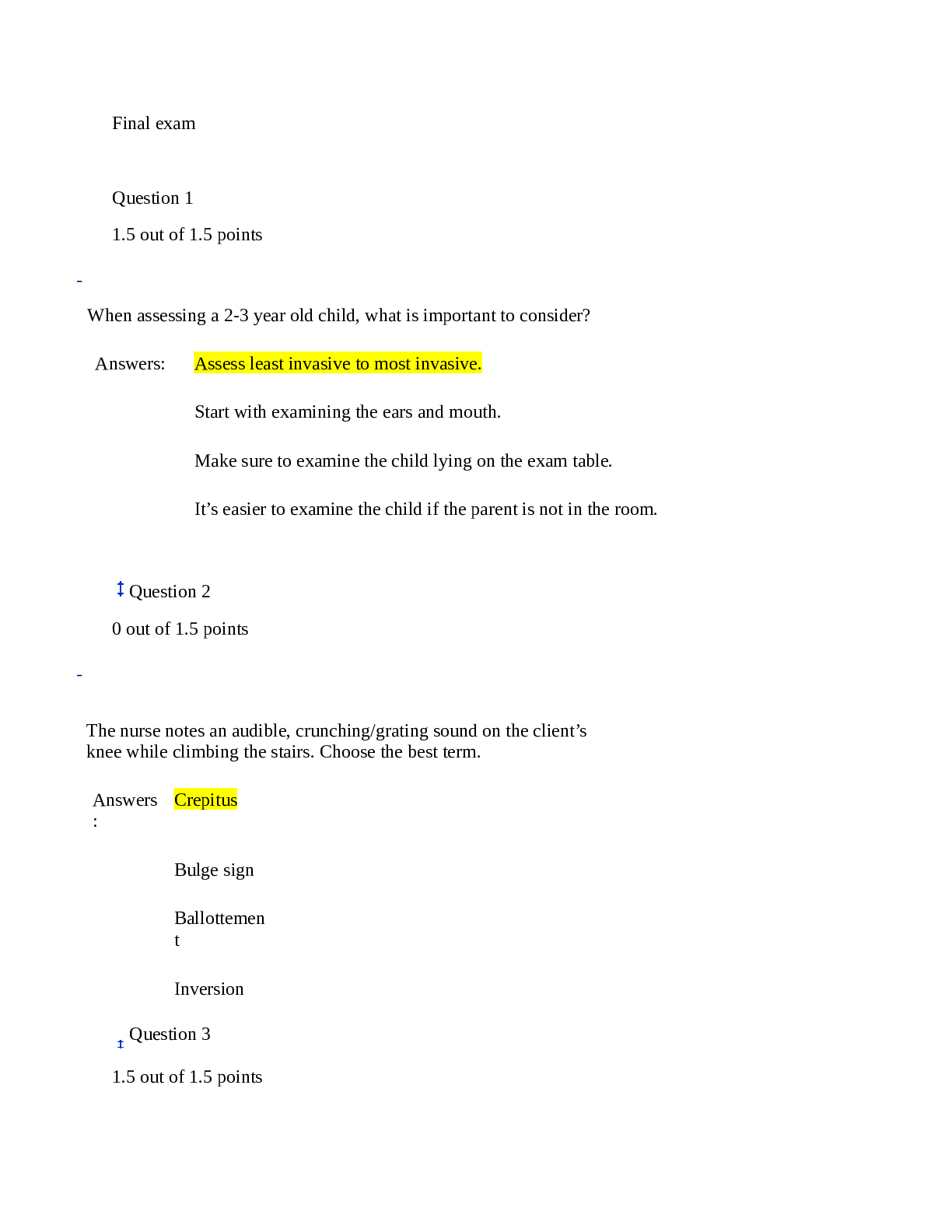
Reviews( 0 )
Document information
Connected school, study & course
About the document
Uploaded On
May 02, 2021
Number of pages
44
Written in
Additional information
This document has been written for:
Uploaded
May 02, 2021
Downloads
0
Views
189




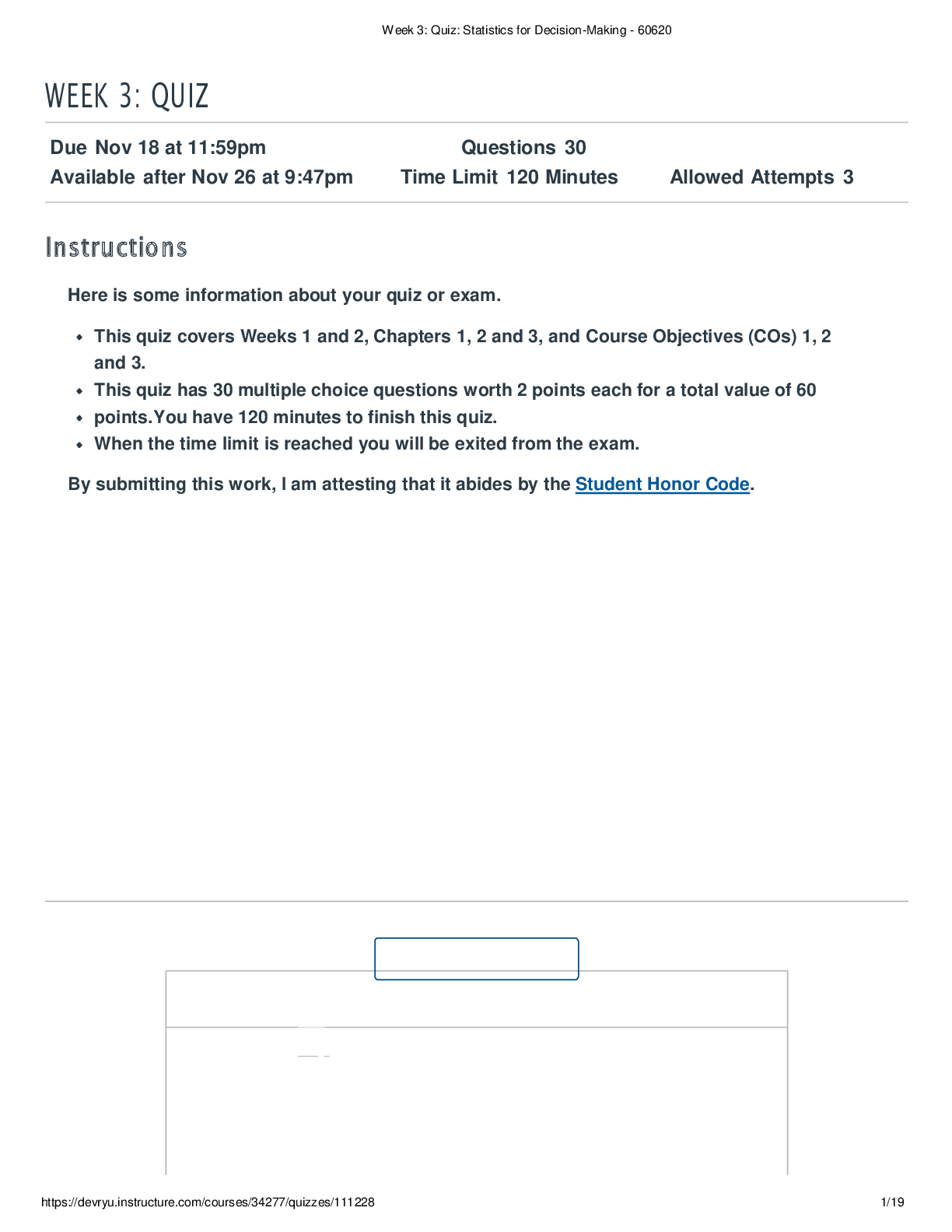

.png)










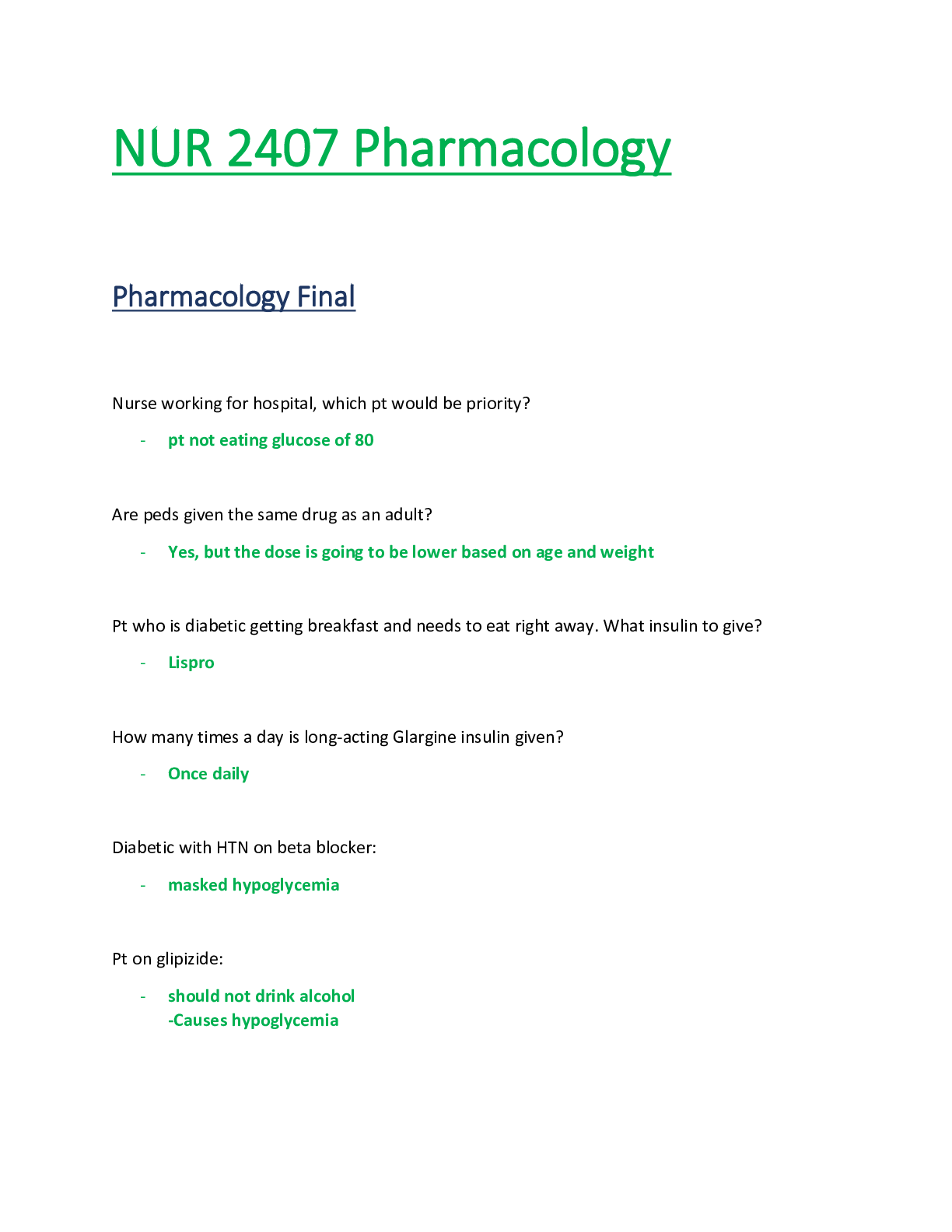
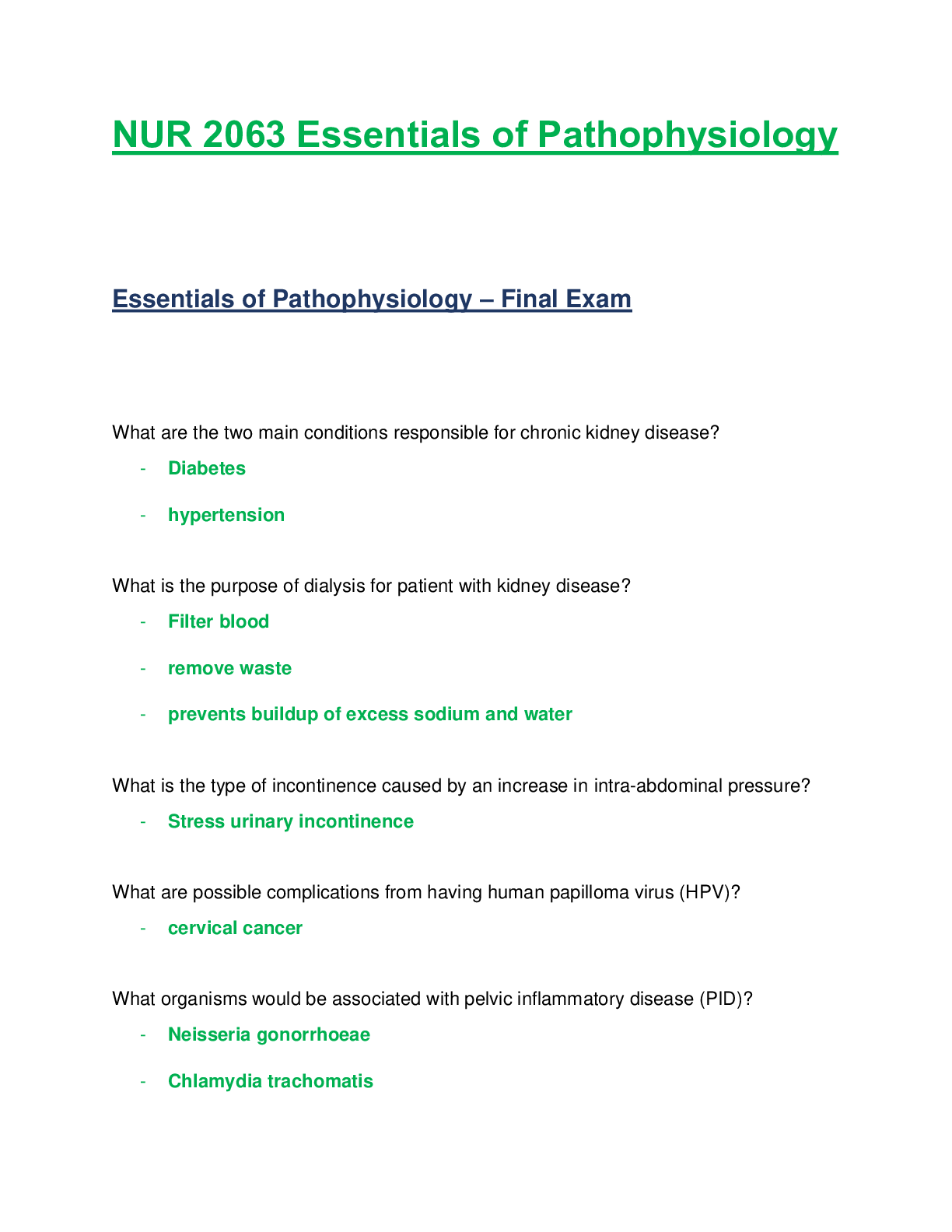
.png)
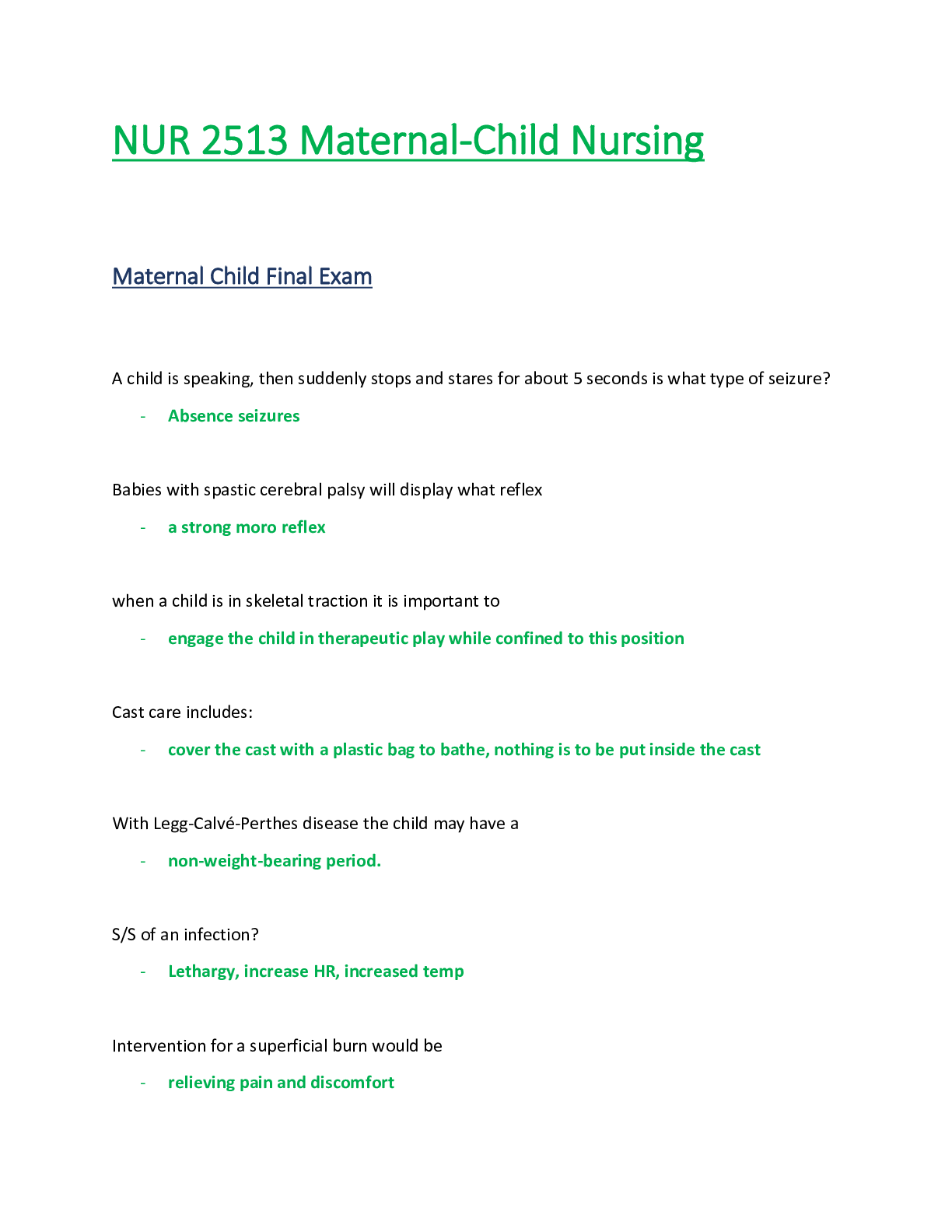

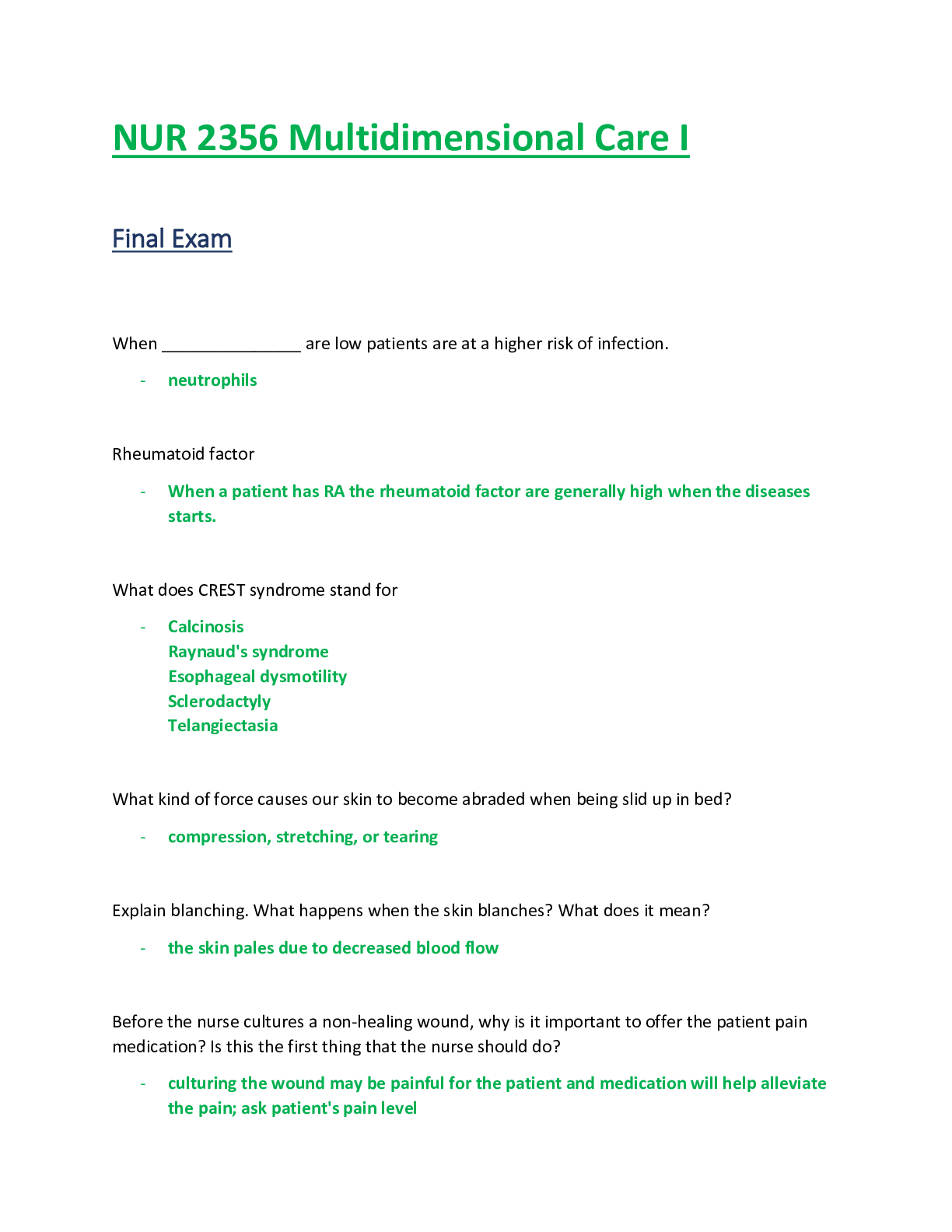
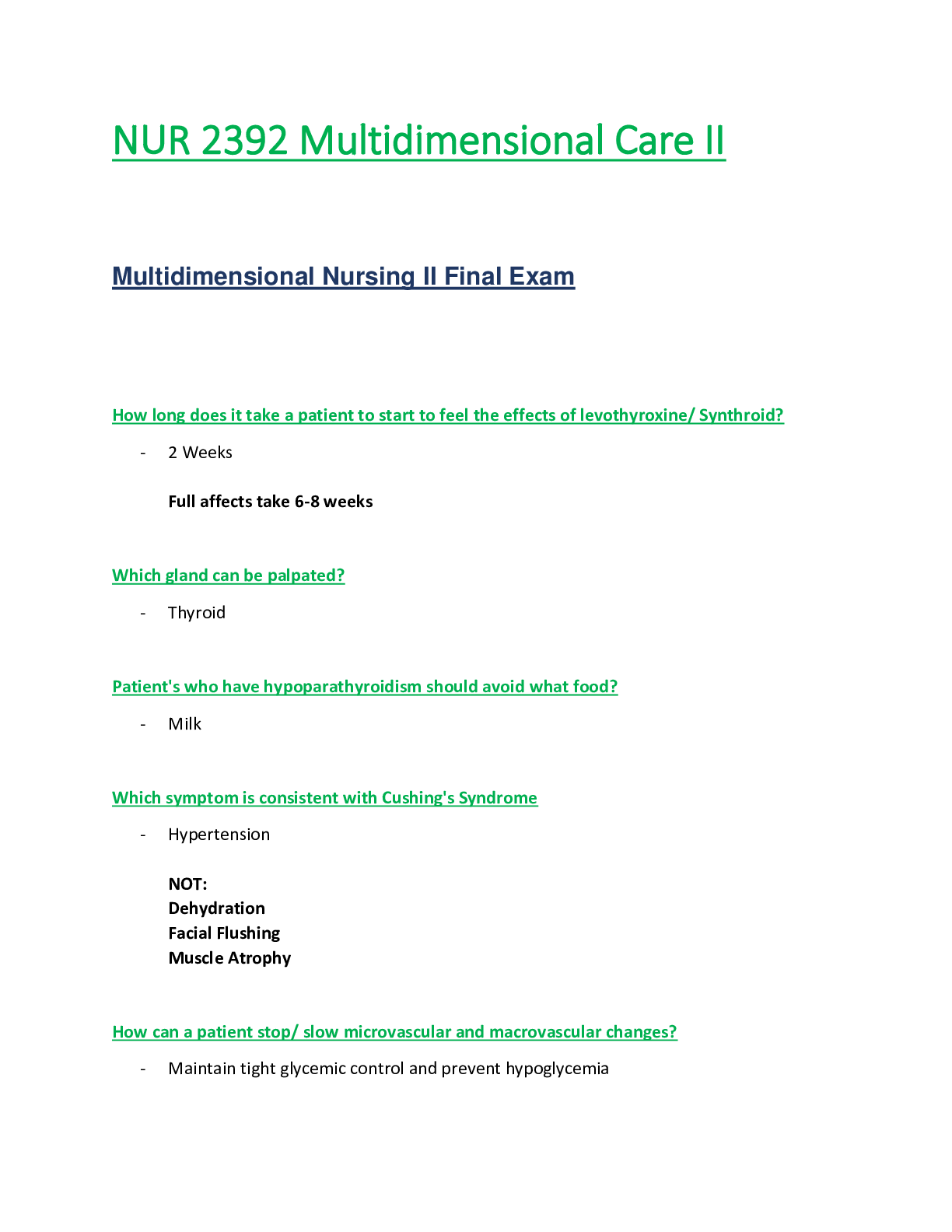
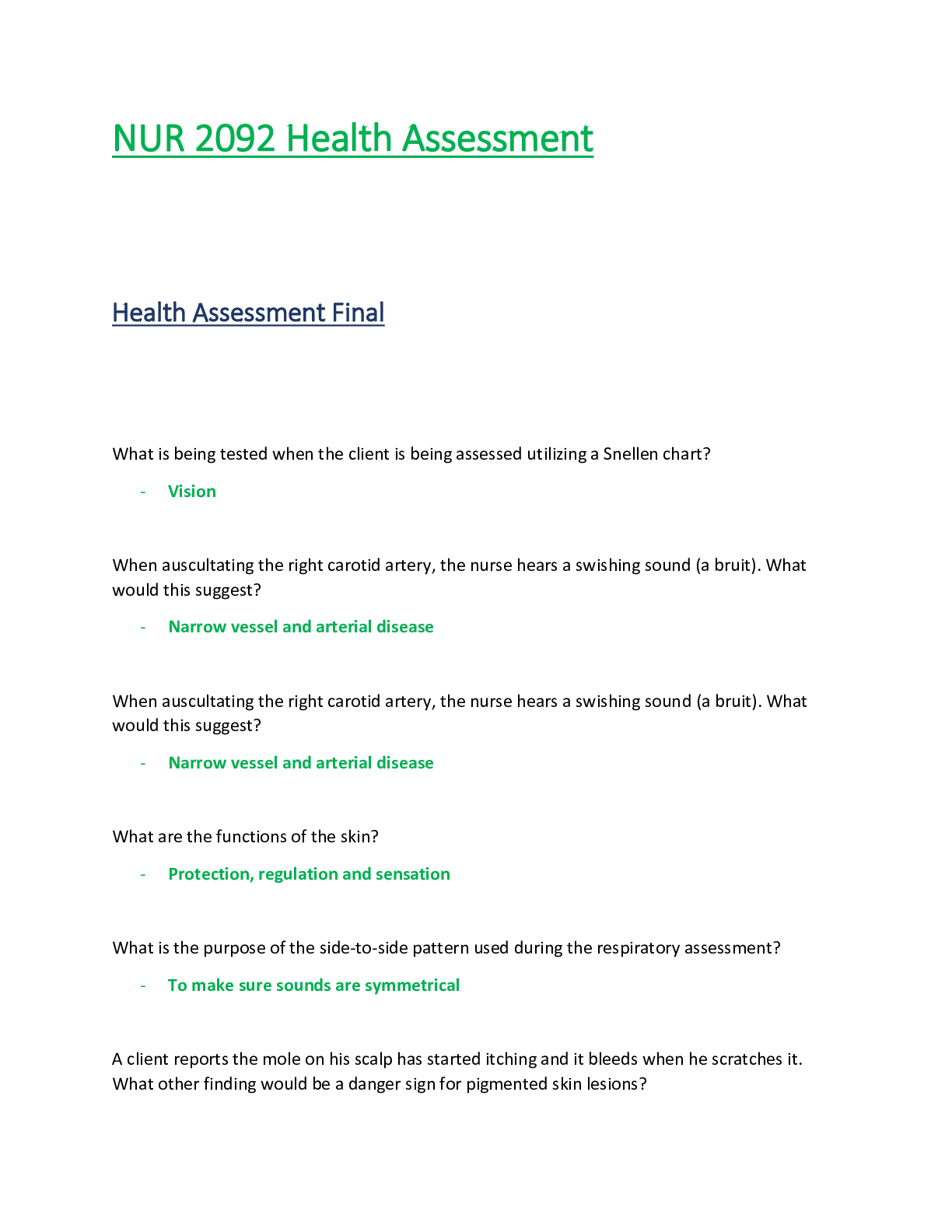
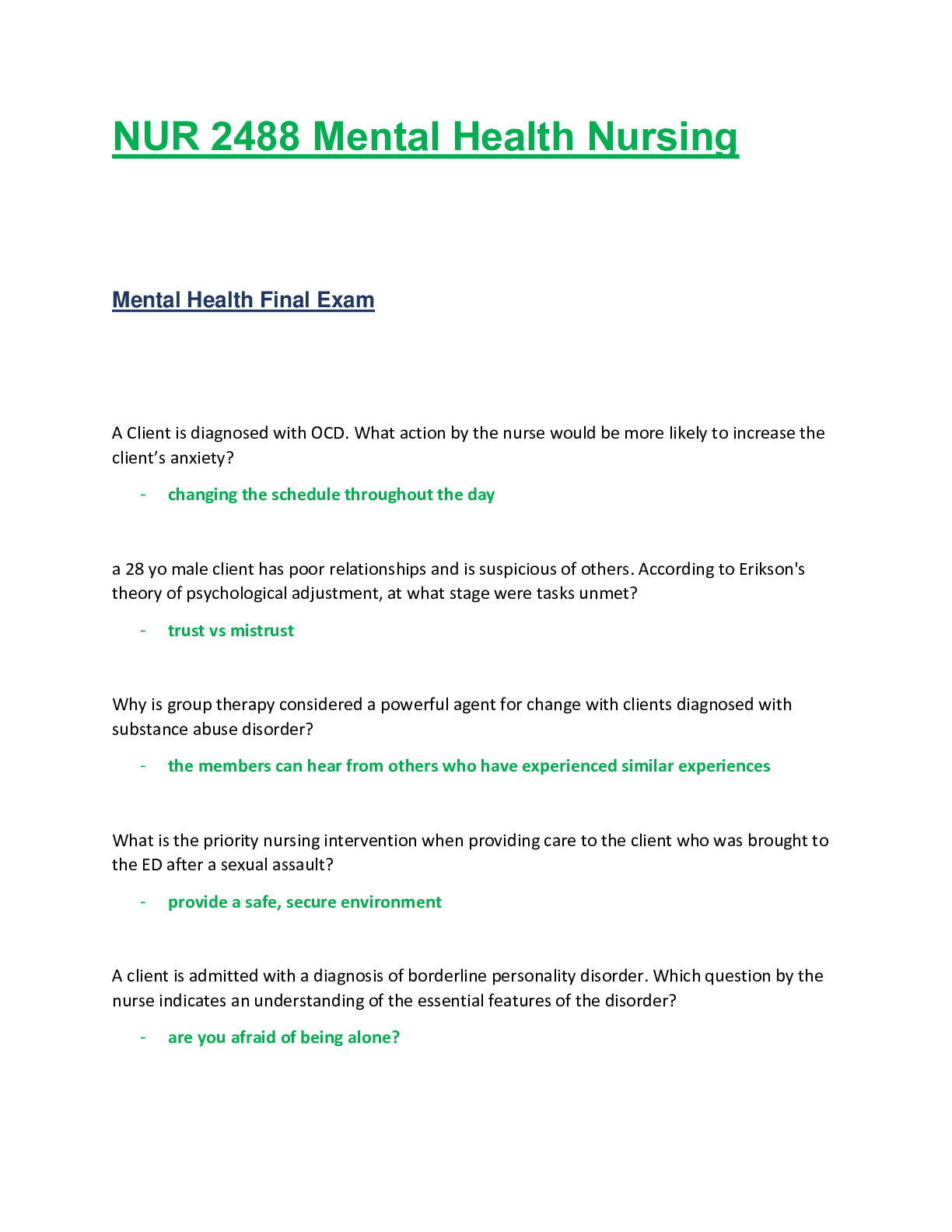
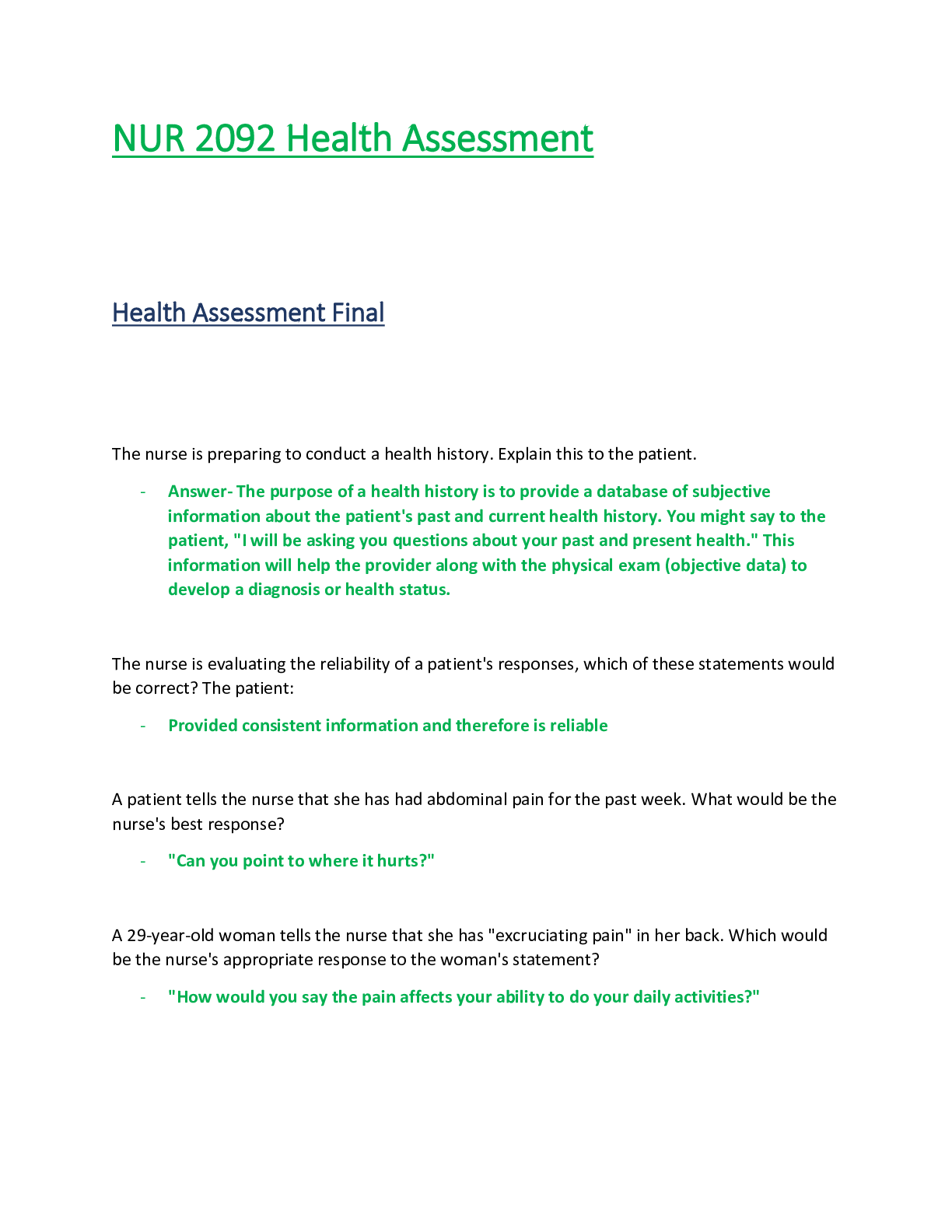
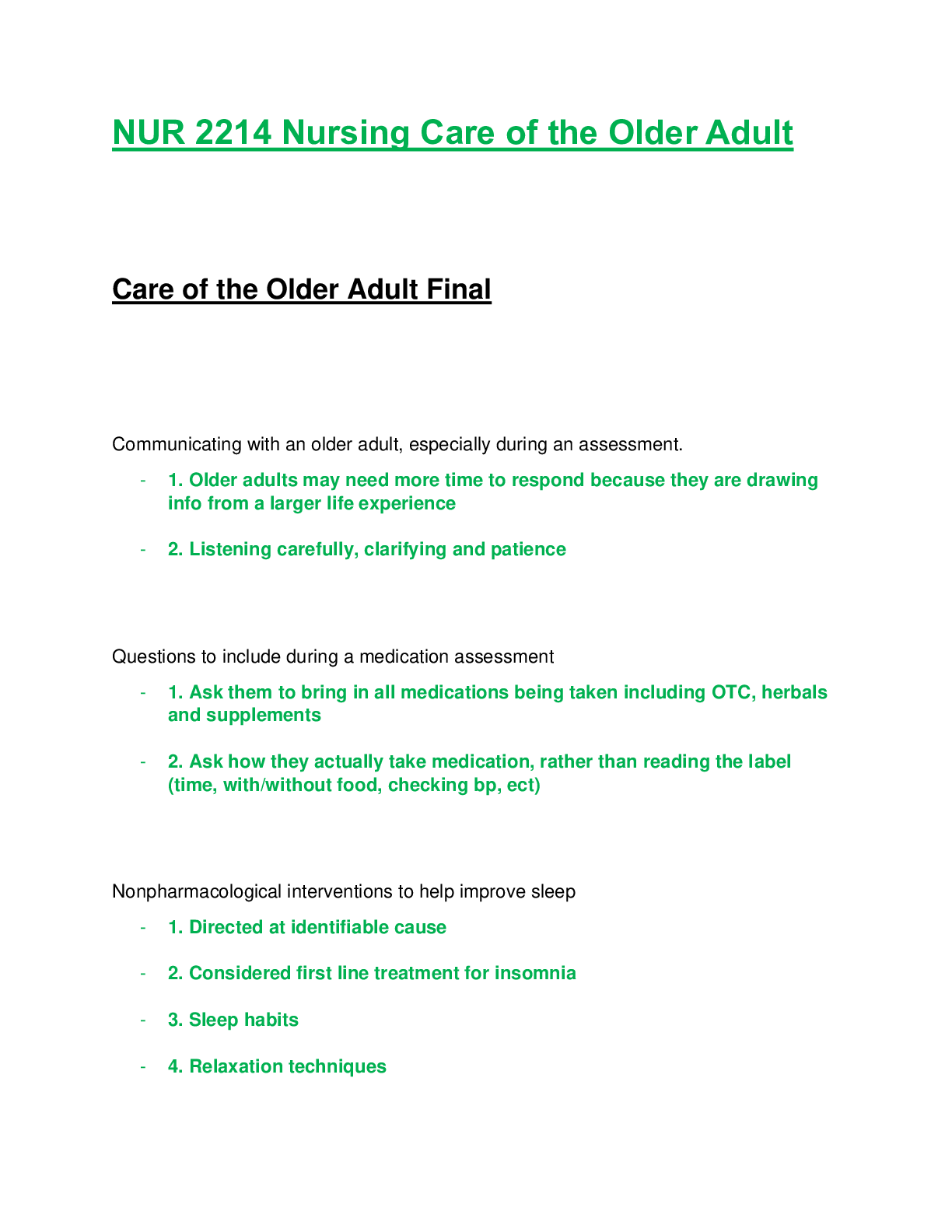
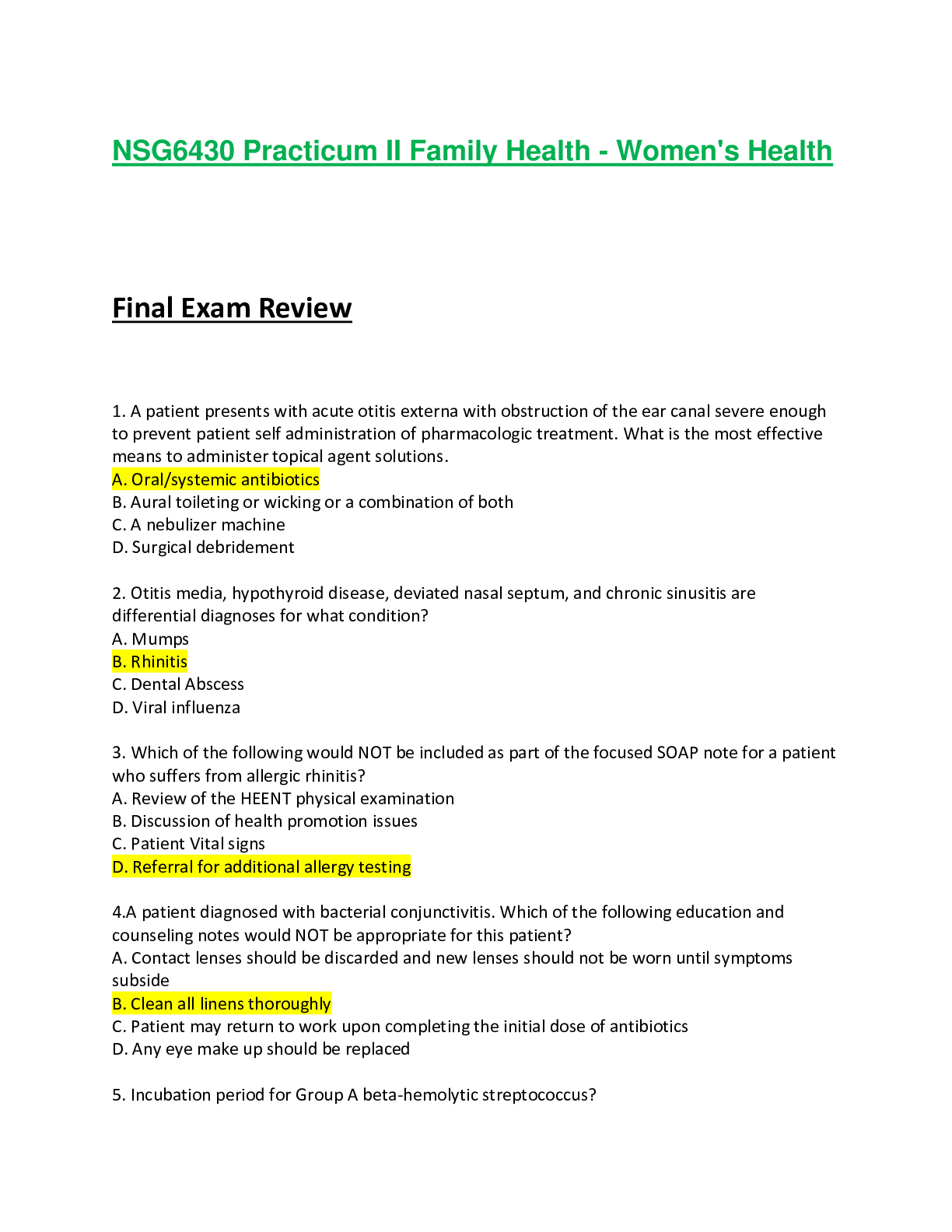
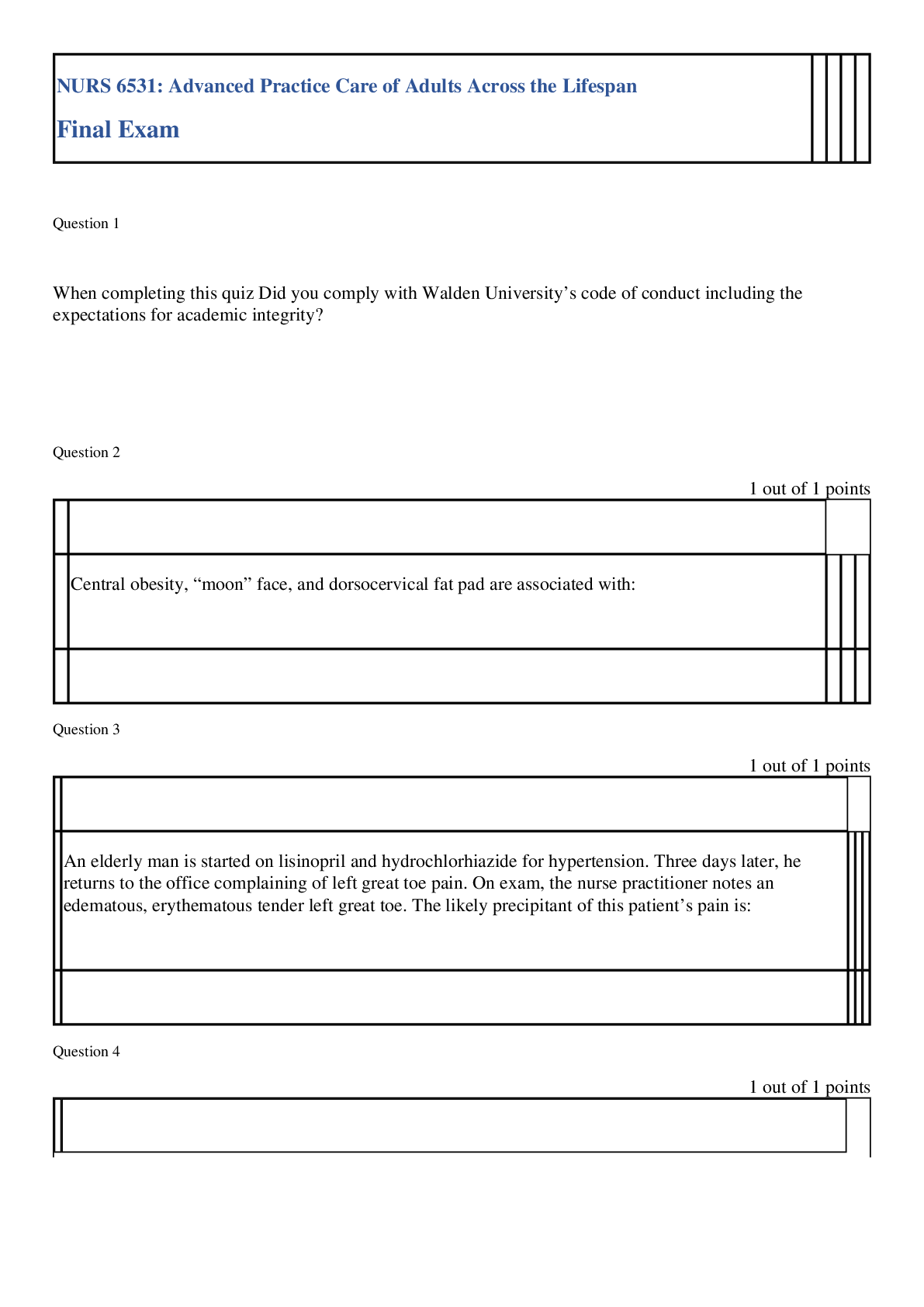
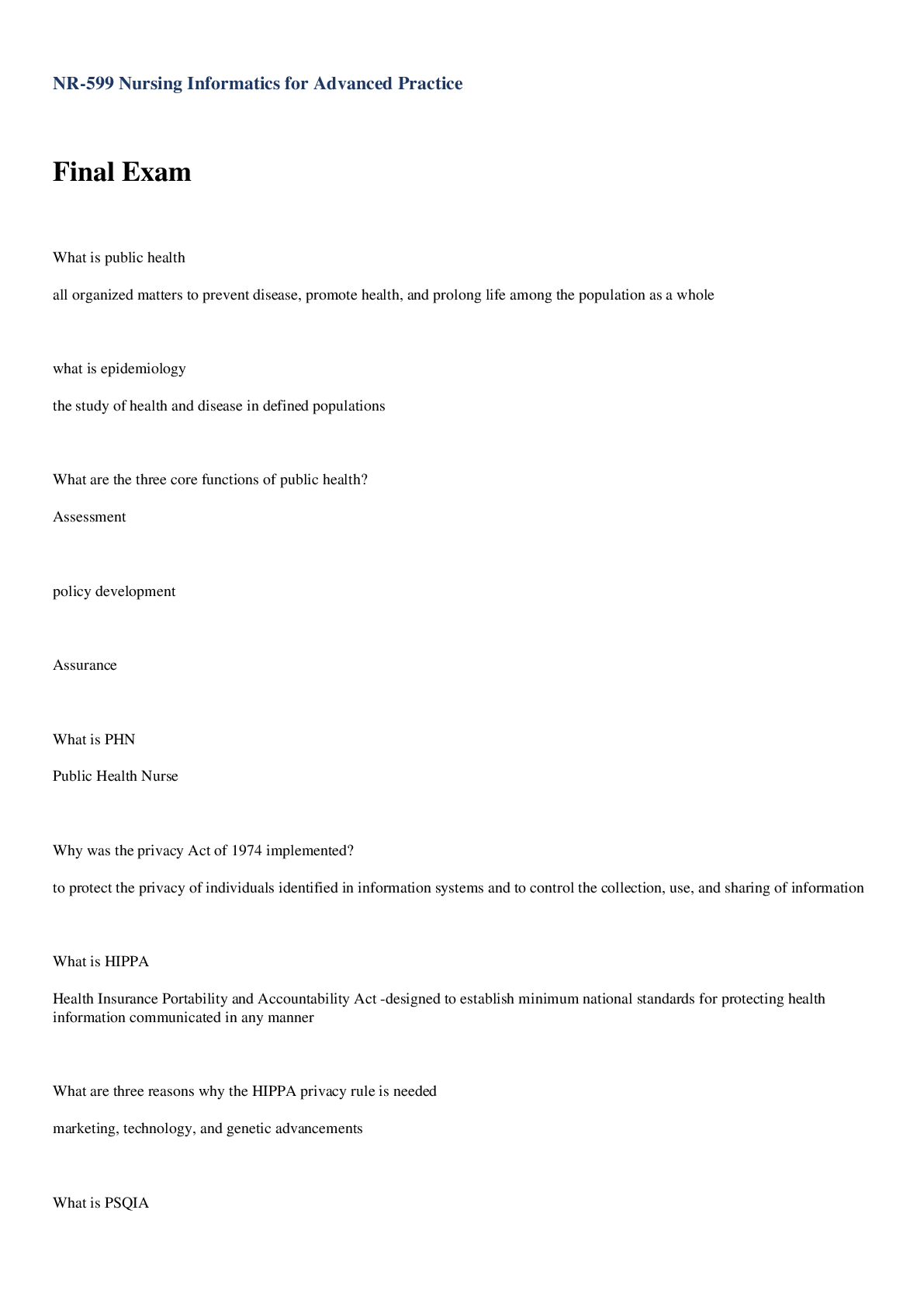
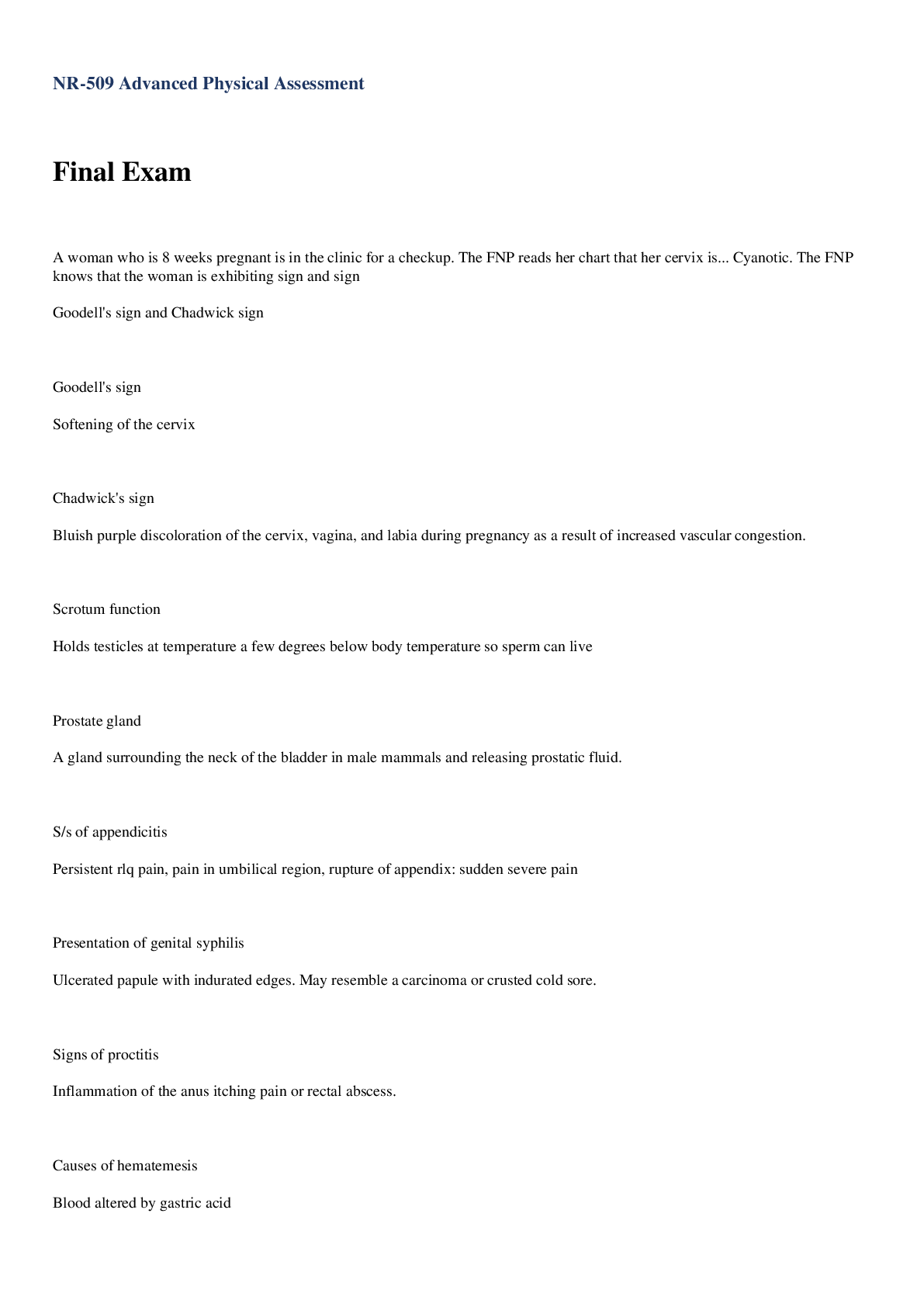


.png)
